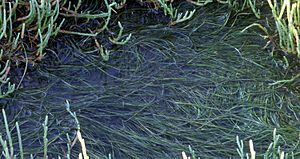Ruppia maritima facts for kids
Quick facts for kids Ruppia maritima |
|
|---|---|
 |
|
| Ruppia maritima | |
| Conservation status | |
| Scientific classification | |
| Genus: |
Ruppia
|
| Species: |
maritima
|
| Synonyms | |
|
Ruppia brachypus J.Gay |
|
Ruppia maritima is a type of aquatic plant often called beaked tasselweed or widgeon grass. Even though its scientific name means "of the sea," it's not truly a marine plant. It's better described as a plant that can handle salty water, but it mostly lives in freshwater. The name Ruppia honors a German botanist named Heinrich Bernhard Ruppius.
Contents
Where Ruppia maritima Lives
This plant can be found all over the world. It usually grows in areas near the coast. You'll often see it in brackish water places like marshes. Brackish water is a mix of fresh and salty water. Ruppia maritima is a very common plant in many shoreline areas. It doesn't grow well in muddy water or places with low oxygen.
What Ruppia maritima Looks Like
Ruppia maritima is a thin, grass-like plant. It can live for one year or many years. It grows from a rhizome, which is like an underground stem. This rhizome is lightly rooted in wet soil.
The plant produces a long, thin stalk. At the end of this stalk are two tiny flowers. These flowers often pollinate themselves. But they also release pollen that floats on bubbles to other plants.
How Ruppia maritima Spreads
The plant produces small fruits called drupelets. These fruits spread in the water. They can also spread after being eaten by fish or waterbirds. The fruits pass through the animals' digestive systems.
Ruppia maritima can also spread without seeds. It grows new plants from its rhizome. This helps it form large groups of plants.
Wetlands and Wildlife
This plant is very important for many animals. It's a food source for some plant-eating waterfowl species. The tiny algae that grow on its leaves are also eaten. However, it's not a main food for birds that eat fish or insects.
In many places, people are working to bring back wetlands. A big part of this work is protecting and helping Ruppia maritima grow. It plays a key role in healthy wetland environments.
See also
 In Spanish: Ruppia maritima para niños
In Spanish: Ruppia maritima para niños



